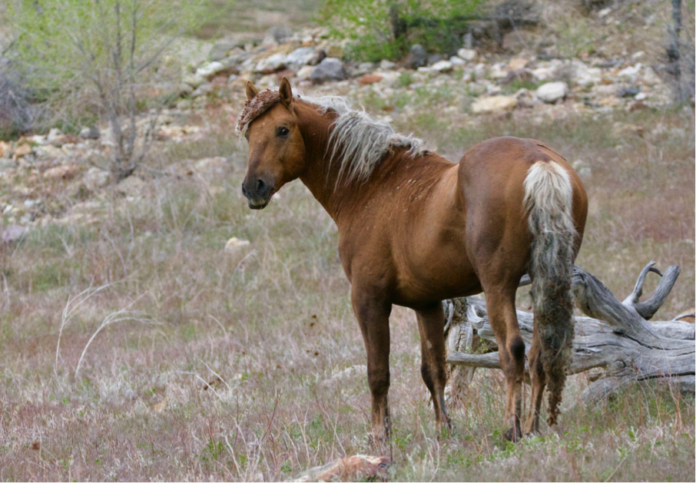BY LARRY BARNES
A band of wild horses shimmering in the heat waves of a gray-green Western expanse is an ancient North American image, lost for a time, but made new by Christopher Columbus. It began when Earth was shocked by an asteroid about 66 million years ago, causing a great extinction. Another 10 million years passed before the first proto horses rose from the ashes of the dinosaurs. These five-toed diminutive tropical forest creatures diversified into rhinoceroses, tapirs, and horses. The horse branch progressively lost its toes and by about 3.5 million years ago became the one-toed running wonders that we would recognize as a modern horse. From their birthplace here in the Americas, the horses, along with rhinos and tapirs, made it to the Old World through Beringia – a gift from the New World.
A migration in the opposite direction brought Earth’s super-predator to the New World around 20,000-40,000 years ago. The Pleistocene extinction that followed has been dubbed the Blitzkrieg Effect for the devastating loss of American megafauna that coincided with the arrival of man. Seventy percent of the large mammals were lost around the period that the novel Homo sapiens was spreading southward toward Tierra del Fuego.
There is much equivocation on this subject in the scientific literature. Maybe the Pleistocene extinctions were climate driven, maybe human caused, maybe both. Undisputed is that nearly every island on Earth experienced a domino extinction effect following the first human footprints in the sand. The scientific notion of parsimony is that the simplest explanation is probably most correct. If mass extinction followed our colonization of every island, why should continent-wide extinctions following man’s arrival be any different?
Regardless, the Pleistocene extinctions left North America bereft of horses for about 10,000 years. By 500 years ago, Columbus and his followers had reseeded North America with escaped horses that found the middle ocean of grass and the Western xeric ranges to their liking. The horses had profound political and economic impacts amongst the Native Americans and later the colonists. The horses thrived, becoming the Mustangs of the West, and all was well except for one thing.
Ecologically, we live in a top-down world. The growth of different members of an ecosystem is often (always?) limited by predators at the top of the food pyramid. Though few in number, predators have an outsized impact on the diversity and robustness of the ecosystems in which they reside. When predators are removed, ecosystems go akimbo. The plants are overgrazed, the soil is exposed, erosion increases, plant diversity is reduced, and the land becomes victim to nature’s vicissitudes. The horses came back, but not their predators, their saber-toothed cats, their dire wolves, their American cheetahs.
These were my recent thoughts upon camping eight nights in a land of wild horses in southeastern Oregon. My tribe of degreed wildlife biologists refer contemptuously to them as “feral” to underscore their non-native and ruinous impact upon the shrub-steppe ecosystems that horses, in their predator-free state, are helping to despoil. The insult to the land was codified by the 1971 Wild Horse Act which secured more protection to feral horses than is provided to real and deserving wildlife, like bighorn sheep!
But as I watched these wild horses – really, for the very first time – pangs of apostasy crept in as I became smitten by them. Moving about in their multicolored bands, the mustangs were alert to their world. They observed us with interest, breaking into a run for no reason, or the slightest reason. Their manes and tails were stiff with cockleburs, they were unkempt and scarred. The mares kicked and bucked dangerously, upholding hidden equine agreements. The foals had one job: stay with mom when she runs, and she always runs.
Humans are surrogate saber-toothed cats now, crudely doing what the missing predators would have done so perfectly. We use helicopters, roundups, birth control, and adoption in an attempt to keep horse numbers down. But on the range, on the move, away from the hand of man, manes flying, hard, nicked bodies propelled by iron-free toes, mustangs bring the shrub-steppe alive with a piece of the Wild.
Larry Barnes retired from 26 years as a biology teacher at Wood River High School and is now transitioning to spending more time exploring the natural world.



